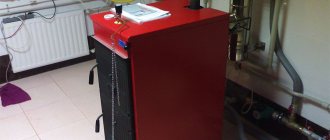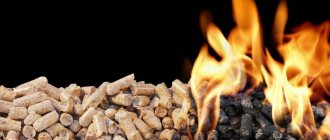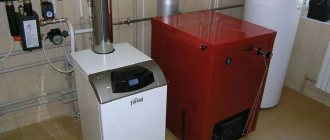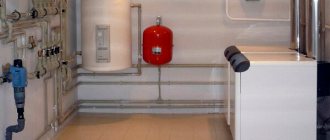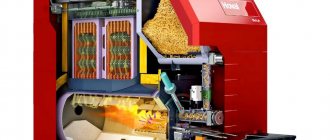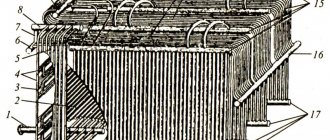The selection of a boiler for any production must be carried out after preliminary calculations. The parameters of the operation of the unit itself are calculated, its functional features (power, type of energy resource or coolant) are taken into account. It is important to know the size of the room in each of the buildings owned by the enterprise (for example, each workshop is taken into account), the number of seasonal days for heating, the desired consumer outlet temperature, etc. Only after taking into account all the nuances can you start choosing a boiler.
Industrial boilers
Specifications:
- power and heating capacity from 150 to 4000 kW;
- maximum temperature 95 - 115 degrees;
- fuel – solid, coal, firewood; gas, light liquid, diesel, fuel oil, exhaust and waste oil;
- burners – imported and domestic;
- pressure 0.3 - 0.6 MPa;
- heated volume of residential and industrial premises and facilities from 2000 to 65700 m3 (depending on the minimum temperature in the region of operation). You can check or select the power of an industrial boiler for your region or any other city using the link.
- are installed in boiler houses of administrative, industrial buildings, heating boiler houses of housing and communal services, and block modular boiler houses.
- used for heating, hot water supply and ventilation of industrial tasks, industrial premises, workshops, hangars, warehouses, garages, greenhouses, production bases, construction camps, hospitals, kindergartens, schools, clubs, sanatoriums, factories, livestock farms, shops, agricultural enterprises and other things.
Buy industrial boilers
On the website of our factory you can choose and buy industrial boilers for a heating or industrial boiler room; we produce boilers for all types of fuel with a capacity from 150 KW to 4 MW. In the boiler model cards, you can find detailed descriptions, prices, connection diagrams, equipment and auxiliary equipment. In addition to hot water industrial boilers, we can offer you the purchase of industrial steam boilers with a capacity of up to 1 ton of steam per hour.
Classification of industrial boilers
- by power;
- by water temperature;
- by water pressure in the boiler;
- on fuel.
- According to the working environment, boiler plants are divided into steam and hot water. By clicking on the link you can select industrial steam boilers.
Power of industrial boilers for boiler houses, water heating temperature and GOST
| Power | Water heating temperature | Purpose | GOST |
| From 100 kW to 4 MW | Up to 95 C° and up to 115 C° | Industrial hot water boilers designed for heating buildings and structures | GOST 30735-2001 Hot water heating boilers with heating capacity from 0.1 to 4.0 MW. General technical conditions |
The power of an industrial boiler is selected based on the required heated volume and the region in which the heated object is located.
Brands of industrial boilers according to GOST 30735
- KVR - with manual firebox;
- KVM - with a mechanical firebox;
- KVA - with atmospheric burners, these include gas, liquid fuel diesel and fuel oil boilers;
- HPC - solid fuel - wood;
- at the end of the designation, letters are used indicating the type of fuel - KB - hard and brown coal, D - firewood, M - fuel oil, GN - low pressure gas, GS - medium pressure gas, LV - light liquid fuel - diesel;
- the brand of industrial boiler contains an indication of the power in MW (megawatt);
- may contain a maximum heating temperature of the coolant - 95 or - 115 degrees.
An example of the designation of industrial heating boilers KVR-0.6 KB; KWm - 2.5 ShP; KVA-1.5 LV; KVR-0.8-95 KB; KVA-2.0 M; KVA- 0.6 H; KVA-1.16 Gs; HPC-0.2 MW and the like.
Brands of industrial boilers from various manufacturers
The production of industrial boilers is carried out by many foreign and Russian boiler plants. Manufacturers often label industrial boilers with a mention of their brand. The most famous manufacturers of boiler equipment and boilers:
- German industrial boilers Buderus;
- domestic boilers of the Rosse brand;
- imported Viessmann boilers;
- Italian Ferroli boilers;
- Altai and Barnaul boilers of the KVR, KVm, KVA, KVZr, KVTs, KVT brands;
- Izhevsk boilers Bogatyr and Arcus;
- industrial boilers made in Russia BISAN.
You can buy an industrial heating boiler with delivery to your enterprise on our website.
Design of industrial boilers for burning various types of fuel
Depending on the type of fuel burned, the designs of thermal installations differ. The most common types of fuel for heat generators:
- hard and brown coal;
- firewood;
- low and medium pressure gas;
- diesel;
- fuel oil;
- used oil;
- liquefied gas;
- peat;
- wood chips and sawdust;
- waste from wood processing industries.
Industrial boilers for solid fuels
Solid fuel industrial boilers come in three types with manual, semi-mechanical and mechanical fireboxes.
Manual heating boilers have a power limit - up to 800 kW for hard coal and 500 kW for brown coal. Power limits are set by the need to load a large volume of fuel manually and the heavy physical work of the fireman.
However, often, owners of industrial boiler houses prefer to increase the number of boiler room operators and buy an industrial boiler with a manual firebox with a capacity of 1000 kW or even 2000 kW. The design of high-power boilers is designed in such a way that they quickly reach thermal power when loading the calculated amount of solid fuel into the firebox.
Solid fuel industrial steel boiler with cast iron grate
The grate is the most common type of combustion device for steel industrial boilers.
Layered grate bars are installed at the bottom of the solid fuel heat generator firebox. Air forced by a fan enters the box under the grate; through the holes in the grate, air is supplied under pressure to the fuel layer. After the fuel burns out, the remaining ash and slag are poured into the combustion chamber under the grate and, as they accumulate, the fireman cleans it manually.
Steel industrial boiler with leak-free cooled grate EUR
A small-capacity industrial steel coal-fired boiler with an EUR furnace is made as a single unit. The combustion device and the pipe system are connected by one unit. The bottom of the combustion part is made of steel pipes embedded in the boiler block. Water moves through the pipes, cooling the surface on which the fuel burns. The EUR grate pipes are welded together with steel plates with slots for air to enter the combustion chamber. Coal is burning on the EUR furnace. Holes in the strip between the pipes prevent burning fuel and ash from falling into the ash collection box.
The design of the EUR furnace ensures a uniform flow of air into the fuel layer and eliminates the failure of slag into the air box of the heat generator. Fur and chemical underburning of coal in heat generators with EUR furnace is lower than in grate generators. The most effective use of the EUR furnace is when burning brown coal with low calorie content.
Coal boilers with tilting grate type RPK
The design of a hot-water steel industrial boiler with a combustion device with rotary grates makes the work of the boiler operator easier.
The RPK grate is assembled from rotary tipping grates. The grate bars have a special design - a flat surface and a support at the bottom for attaching them to the rotary shaft. Fuel combustion occurs on a layered fixed grate; as the fuel burns, the fireman moves the resulting slag onto the rotary grate. By turning the lever as necessary, the fireman discharges the slag into the ash removal channel.
A slag removal conveyor or a conventional storage hopper can be installed under the boiler installation, from where the slag is subsequently removed on a trolley outside the boiler room. Rotary grate bars in the firebox can be located in different areas of the front or rear, depending on the layout of the boiler room. For large boilers, the entire surface of the combustion part of the boiler unit can be made of rotary grates.
Wood fired industrial boilers
Wood-burning industrial boilers are used in areas where the price of firewood is low or the enterprise has a sufficient amount of wood processing waste.
The design of industrial wood boilers differs from coal boilers. The main difference is the large volume of the firebox. Wood fuel is lower in calories and much larger in volume compared to coal, therefore, to generate the same power, it is necessary to burn and load a large volume of firewood at once.
Criterias of choice
When purchasing units, pay attention to the following:
- Equipment power. Calculated based on the formula: 1 kW per 10 m². Additionally, possible heat losses are taken into account. Therefore, it is recommended to purchase a unit with a power reserve of 25-30%.
- Connecting the water heater to the network: single or three-phase (220 V and 380 V, respectively).
- Type of equipment: with heating element, electrode or induction.
- Performance: single or double circuit device. The latter is capable of not only heating an industrial facility, but also providing it with hot water supply.
Also, when choosing, take into account the characteristics of the room itself, the region, the operation of the local electrical network (voltage, possible power outages), the presence of additional options, etc.
Industrial boilers with automatic (mechanical) fireboxes
Mechanized industrial boilers for boiler houses are produced with a power of 800 kW. The design of the heating plants is two-block, the firebox is mounted separately and the boiler side is mounted. The types of mechanical furnaces for boiler units are also different.
Solid fuel boilers with thrower
The design of a mechanical industrial steel boiler consists of three blocks - the thrower, the firebox and the boiler block. Coal is thrown into the boiler using a pneumomechanical thrower type ZP or PTL. The process of throwing coal into the furnace is fully automated.
A boiler of this design requires a fuel and slag scraper conveyor, a crusher and a bunker.
Mechanical boilers with TShPM with a screw strip
Coal enters the TShPM bunker using a scraper coal feed conveyor. From the hopper, coal is poured onto the firebox grate block. The burning fuel is moved along the firebox grate by a rustling bar.
Ash and slag formations are moved to the end of the TShPM furnace onto a rotating grate. When the grate is rotated, the ash is poured into the slag removal channel and moved by a conveyor to the slag bunker or dump.
Industrial boilers with direct combustion furnace type TLPH
The fuel enters the TLPH furnace bunker using a scraper fuel supply conveyor. From the hopper, coal is poured onto a belt grate. The grate blade moves slowly from the front of the boiler using a gearbox. The fuel gradually burns and when the blade at the end of the furnace is turned, the slag and ash are tipped into the slag removal channel and moved by conveyor to the ash and slag bunker or to the dump.
The power of an industrial boiler is regulated through the speed of movement of the grate cloth and the thickness of the transported fuel layer.
Operating conditions
For uninterrupted operation of the equipment, a connection to the gas supply is required. Such units are suitable for the following objects:
- Tsekhov.
- Warehouses.
- Utilities premises.
- Office buildings, buildings.
- Indoor stadiums, grounds and training grounds.
The popularity of blue fuel is due to its low cost, so such boilers are superior to other types in terms of efficiency. Their design includes a burner from which gas comes, as well as a copper heat exchanger.
In addition, the equipment contains a steam pump, a pressure gauge that measures fuel pressure, and a thermometer that is used to estimate the current temperature. The working fluid is in a special reservoir.
Industrial boilers with burners
Heating units with burners include boilers using low and medium pressure gas, liquid fuel boilers using light diesel fuel, waste oil, and fuel oil. Burners can be domestic or imported from various manufacturers. If you decide to install a non-design burner, you must check the compatibility in terms of the length and width of the burner flame opening angle. When the burner torch is thrown onto the walls of the furnace, the pipes may burn out. The inspection is carried out by the industrial boiler plant.
Gas industrial heating boilers
The design of gas industrial heat generators consists of two blocks - a firebox and a convective part. At the front of the firebox, a door is made to service the combustion chamber. A hole is made in the door with a mount for the burner. To monitor the combustion process, there is a peeper with a viewing glass. Hot gases exit the firebox at the top of the combustion chamber and enter the convection sections. Sections of convective packages are installed as a block. Hot gases from the boiler block exit from the rear at the top.
Liquid fuel industrial boilers using waste oil and diesel
The design of boiler units using liquid fuel and waste oil involves working with liquid fuel burners; the dimensions of the boiler block are slightly larger than those of a purely gas boiler. Industrial heating boilers using waste oil work with burners from various manufacturers. It is possible to use a gas-diesel burner, but in order to obtain maximum efficiency of the boiler installation, it is necessary to buy an industrial boiler that runs on diesel.
Industrial oil boilers for boiler houses
Fuel oil boilers may not differ in appearance from diesel ones, but in terms of the ratio of heating surfaces for fuel oil, more of them are required; therefore, with the same power, an oil boiler will be more expensive. It is also not recommended to burn gas in a fuel oil boiler, because gas has a lower dew point and condensation and intense corrosion may begin to form in the tail heating surfaces.
Multi-fuel industrial boilers
Multi-fuel heating boilers with a power of more than 100 kW are not efficient. Each fuel has its own characteristics and design requirements. You cannot burn coal, wood, gas, diesel and fuel oil equally efficiently in one boiler. If you are looking for such an option, be careful, immediately decide which fuel will be the main one and which one will be the backup one, and carefully study the technical characteristics when working on each type of fuel.
Comparison of fuel consumption and price per 1 MW of generated heat for gas and liquid fuel boilers
| Peculiarities | Gas | Diesel | Fuel oil |
| Efficiency,% | 91 | 91 | 86 |
| Fuel consumption | 117 m³/h | 110 liter/h | 102 kg/h |
| Fuel price (for 2022), rubles | 6 | 47 | 20 |
| Price for generating 1.0 MW of heat per hour, rubles | 734 | 5290 | 2103 |
Comparison of fuel consumption and price per 1 MW of generated heat for solid fuel coal and wood boilers
| Peculiarities | Coal with manual combustion | Coal with mechanical firebox | Wood burning | Coal/Firewood |
| Efficiency,% | 80 | 80 | 81 | 80/73 |
| Fuel consumption, kg/h | 205 | 341 | 433 | 205/499 |
| Fuel price (for 2022), rubles | 2,97 | 2,97 | 1,28 | 2,97/1,28 |
| Price for generating 1.0 MW of heat per hour, rubles | 609 | 1015 | 554 | 609/639 |
Industrial boilers prices and availability
Current prices for industrial boilers are listed on our website. The cost of industrial boilers, the production of which is carried out on special order, is calculated during the working day.
Industrial heating boilers with a capacity of up to 1 MW using solid fuel are always in stock at our Boiler Plant.
The boiler plant produces industrial boilers to order within 10-20 days.
The sale of industrial boilers in Russia, Kazakhstan, Mongolia, Tajikistan, Uzbekistan and Belarus is carried out on the basis of a non-cash agreement. You can buy an industrial boiler by placing an order through the feedback form on our website.
manufacturer's warranty
At the manufacturing plant, industrial boilers for boiler houses are subjected to a hydraulic pressure test of 0.9 MPa (9 kgf/cm2).
The certificate of conformity for industrial boilers is issued in accordance with technical regulations TR CU 010 and TR CU 032, for gas boilers TR CU 016.
Warranty service includes free elimination of hidden factory defects, replacement of parts and assemblies that fail during the warranty period, provided that the equipment is installed and operated by the Buyer in accordance with its purpose, technical documentation, technical standards, rules for commissioning and operation of this equipment.
The service life of an industrial boiler is 10 years.
Conclusions - which energy resource is most beneficial for boiler companies
Approximate financial waste (on average) for seasonal heating of a room of 1000 sq.m. taking into account different prices on the market, if you heat:
- Coal (brown) – 192 thousand rubles.
- Pellets – up to 434 thousand rubles.
- Oak firewood – 110 thousand rubles.
- Diesel – 710 thousand rubles.
- Gas (natural) – 130 thousand rubles.
- Electricity – up to 420 thousand rubles.
After the reviewed reviews, the following conclusion suggests itself - the most profitable in terms of money spent are solid fuel boilers. The savings consist of reduced cash costs when purchasing raw materials, as well as slow combustion in order to obtain the maximum required efficiency.
But their advantages are obvious only when mechanical heat loss is minimized. And to do this, before installing and starting up the boiler room, you must first insulate the building itself well. In addition, pellets are too expensive to use for heating industrial premises.

